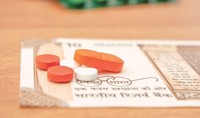Advertisement
Grab your lab coat. Let's get started
Welcome!
Welcome!
Create an account below to get 6 C&EN articles per month, receive newsletters and more - all free.
It seems this is your first time logging in online. Please enter the following information to continue.
As an ACS member you automatically get access to this site. All we need is few more details to create your reading experience.
Not you? Sign in with a different account.
Not you? Sign in with a different account.
ERROR 1
ERROR 1
ERROR 2
ERROR 2
ERROR 2
ERROR 2
ERROR 2
Password and Confirm password must match.
If you have an ACS member number, please enter it here so we can link this account to your membership. (optional)
ERROR 2
ACS values your privacy. By submitting your information, you are gaining access to C&EN and subscribing to our weekly newsletter. We use the information you provide to make your reading experience better, and we will never sell your data to third party members.
Generics
Covid-19
India partially lifts drug export ban on hydroxychloroquine and acetaminophen
Country will now allow exports if domestic needs are met to treat COVID-19
by K. V. Venkatasubramanian, special to C&EN
April 8, 2020
| A version of this story appeared in
Volume 98, Issue 14

Late last month, India banned the export of many pharmaceuticals as well as ventilators and other supplies deemed necessary to treat people with COVID-19. On April 6, the country partially reversed course after a phone call between Prime Minister Narendra Modi and US President Donald J. Trump.
One of the drugs affected by the export ban is hydroxychloroquine, an antimalaria drug repeatedly touted by Trump for its possible use against SARS-CoV-2, the virus that causes COVID-19. Clinical studies are underway to determine whether the drug is safe and effective to use against COVID-19. Hydroxychloroquine and its predecessor, chloroquine, can cause severe side effects, including heart problems.
During a press briefing after the call with Modi, Trump said, “If he doesn’t allow it to come out, that would be okay, but, of course, there may be retaliation. Why wouldn’t there be?”
Indian officials now say that exports of hydroxychloroquine and acetaminophen, which is used for pain and fever relief, will be permitted on humanitarian grounds depending on stock availability after meeting domestic requirements. Ministry of External Affairs spokesperson Anurag Srivastava says that supplies of the two drugs will be continuously monitored.
C&EN has made this story and all of its coverage of the coronavirus epidemic freely available during the outbreak to keep the public informed. To support our journalism, become a member of ACS or sign up for C&EN's weekly newsletter.
India also lifted export bans on 24 other pharmaceutical ingredients and formulated drugs, including several antibiotics and vitamins.
India initially limited exports of pharmaceuticals for COVID-19 on March 3, then further tightened export restrictions after Modi ordered a 21-day, nationwide lockdown beginning March 25. The drug export limits were intended to address rising concern about the country’s ability to meet domestic needs amid a surge of COVID-19 cases. As of C&EN’s deadline, India had 5,274 confirmed cases and 149 deaths from COVID-19, according to its Ministry of Health and Family Welfare. India has a population of about 1.4 billion people.
India provides most of the world’s generic drugs, and nearly half of the US supply of hydroxychloroquine in 2019 came from India, according to Bloomberg Intelligence.
As Trump was lobbying Modi to allow exports of hydroxychloroquine, US actions stopped 3M from sending US-made N95 respirator masks to Canada and Latin America and allegedly diverted shipments of medical supplies to Germany and France. 3M and the Trump administration subsequently reached a deal allowing the company to resume exporting masks.




Join the conversation
Contact the reporter
Submit a Letter to the Editor for publication
Engage with us on Twitter